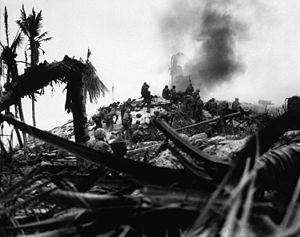- Gilbert and Marshall Islands campaign
-
Gilbert and Marshall Islands campaign Part of World War II, Pacific War
U.S. Marines attack a Japanese stronghold during the Battle of TarawaDate November, 1943 – February, 1944 Location Gilbert and Marshall Islands, Pacific Ocean Result American victory Belligerents  United States
United States Empire of Japan
Empire of JapanCommanders and leaders  Chester W. Nimitz
Chester W. Nimitz
 Holland Smith
Holland Smith
 Richmond K. Turner
Richmond K. Turner
 Ralph C. Smith
Ralph C. Smith
 Marc A. Mitscher
Marc A. Mitscher
 Harry W. Hill
Harry W. Hill
 Thomas E. Watson (USMC)
Thomas E. Watson (USMC) Kōsō Abe
Kōsō Abe
 Kanemitsu
Kanemitsu
 Keiji Shibazaki †
Keiji Shibazaki †
 Seizo Ishikawa
Seizo Ishikawa
 Monzo Akiyama †
Monzo Akiyama †
 Chūichi Hara
Chūichi Hara
 Yoshimi Nishida †
Yoshimi Nishida †Casualties and losses 1,800 dead or missing,
4,830 wounded17,000 dead,
141 capturedPacific Ocean theaterHawaii – Marshalls-Gilberts raids – Doolittle Raid – Coral Sea – Midway – Ry – Solomons – Aleutians – Gilberts and Marshalls – Marianas and Palau – Volcano and Ryukyu – CarolinesIn the Pacific Theater of World War II, the Gilbert and Marshall Islands campaign, from November 1943 through February 1944, were key strategic operations of the United States Pacific Fleet and Marine Corps in the Central Pacific. The campaign was preceded by a raid on Makin Island by U.S. Marines in August, 1942.
Japanese bases in the Gilbert and Marshall Islands were the outer perimeter of eastern defenses for the Japanese Empire. The Marianas campaign followed the next summer.
Background
The Japanese forces occupied the Gilbert Islands 3 days after the attack on Pearl Harbor, Hawaii. As a provided token defense of Tarawa, they built a seaplane base on Makin and dispersed troops along the coastlines of the atolls to monitor the Allied forces movement in South Pacific.[1] It was only after Carlson's Raiders attacked Makin in August 1942 that the Japanese began to fortify and reinforce the Gilberts.[2] The largest and most strategically important islands of the Gilberts was Tarawa. Fortifications were quickly built up by the Japanese starting in March 1943 with nearly 5,000 troops stationed abroad. An additional 3,000 Special Naval Landing Force and base force troops and 940 naval construction units were supplemented by 1,247 laborers.
By comparison, the Makin islands were held by only a total of 798 combat troops, including some 100 isolated Japanese aviation personnel.[3] General Holland M. Smith, Commanding General of V Amphibious Corps blamed the Carlson raid for the rapid build-up of Japanese forces and staunchly felt, even long after his retirement, that Tarawa should have been bypassed, instead of incurring heavy Marine casualties during the seizure.[1][4] Admirals Chester W. Nimitz, Ernest King and Raymond A. Spruance believed that retaking the Gilberts was essential and strategically important for continued movement toward the Marshall Islands. The code name for the capture of the Gilberts was Galvanic,[3][4] which called for the seizures of Tarawa, Makin and Apamama.
References
- ^ a b Samuel Eliot Morison, History of United States Naval Operations in World War II, Vol. 7; Aleutians, Gilberts and Marshalls: June 1942-April 1944, (Edison, NJ: Castle Books, 2001).
- ^ Bruce F. Meyers, Swift, Silent, and Deadly: Marine Amphibious Reconnaissance in the Pacific, 1942-1945, (Annapolis, MD: Naval Institute Press, 2004).
- ^ a b Benis M. Frank and Henry I. Shaw, Jr., History of U.S. Marine Corps Operations in World War II, Vol. 5; Victory and Occupation, (New York, NY: Penguin Books, 1990).
- ^ a b Gen. Holland M. Smith and Perry Finch, Coral and Brass, (New York: Viking, 1974, 1976).
Further reading
- Drea, Edward J. (1998). "An Allied Interpretation of the Pacific War". In the Service of the Emperor: Essays on the Imperial Japanese Army. Nebraska: University of Nebraska Press. ISBN 0-8032-1708-0.
- Dyer, George Carroll (1956). "The Amphibians Came to Conquer: The Story of Admiral Richmond Kelly Turner". United States Government Printing Office. http://www.ibiblio.org/hyperwar/USN/ACTC/index.html. Retrieved May 5, 2011.
- Hoyt, Edwin P. (1978). Storm Over the Gilberts: War in the Central Pacific 1943. Mason/Charter. ASIN B001RSIDF8.
- Wright III, Burton. Eastern Mandates. World War II Campaign Brochures. Washington D.C.: United States Army Center of Military History. CMH Pub 72-23. http://www.history.army.mil/brochures/eastman/eastman.htm.
World War II Participants Timeline - End in Africa
- Kursk
- Smolensk
- Solomon Islands
- Sicily
- Lower Dnieper
- Italy
- Gilbert and Marshall
- Changde
Aspects GeneralWar crimes- German and Wehrmacht war crimes
- The Holocaust
- Italian war crimes
- Japanese war crimes
- Unit 731
- Allied war crimes
- Soviet war crimes
- United States war crimes
- German military brothels
- Camp brothels
- Rape during the occupation of Japan
- Comfort women
- Rape of Nanking
- Rape during the occupation of Germany
- Nazi crimes against Soviet POWs
- Italian prisoners of war in the Soviet Union
- Japanese prisoners of war in the Soviet Union
- Japanese prisoners of war in World War II
- German prisoners of war in the Soviet Union
- Finnish prisoners of war in the Soviet Union
- Polish prisoners of war in the Soviet Union
- Romanian prisoners of war in the Soviet Union
- German prisoners of war in the United States
Categories:- Pacific Ocean theater of World War II
- History of the Marshall Islands
- 1944 in the Marshall Islands
- 1945 in the Marshall Islands
- Wars involving the Marshall Islands
Wikimedia Foundation. 2010.

